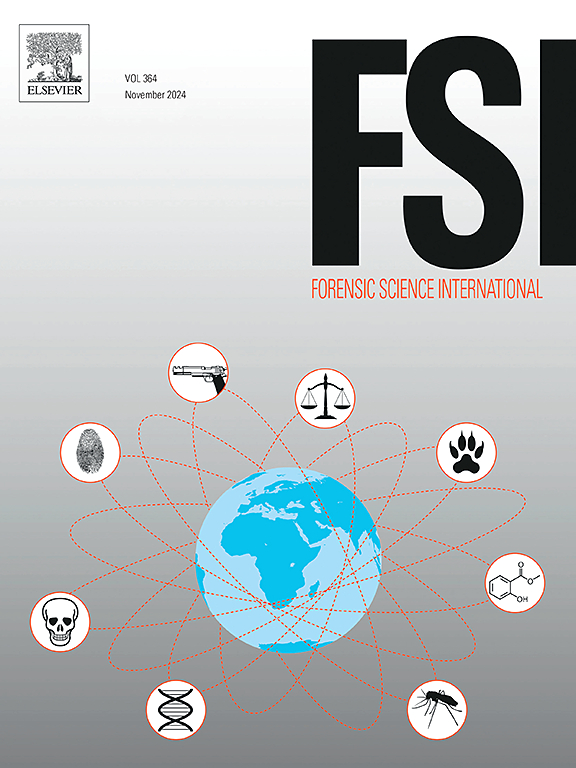Differential human bone remodeling rates and implications for the temporal resolution of geoprofiling isotopes
IF 2.5
3区 医学
Q1 MEDICINE, LEGAL
引用次数: 0
Abstract
Isotopic analysis of human skeletal remains helps individuate decedents in forensic contexts by providing diet and residence information during life. The time represented (adolescence, middle adulthood) and the amount of time averaged (years, decades) depends on a bone’s remodeling rate (RMR). Measuring isotopic values of multiple bones with different RMRs has been used to detect an individual’s residential mobility and major changes in dietary practices. However, RMRs for the majority of human bones have not been adequately quantified, so the temporal resolution of bone isotopes is not well known. Here we utilized reported fraction modern radiocarbon (F14C) values of known decedents to estimate RMRs for the following elements, structures, and phases: cortical and trabecular femoral collagen, cortical tibial collagen and bioapatite, cortical and trabecular rib collagen, cortical occipital and parietal collagen, and trabecular vertebral collagen. Non-parametric comparisons yielded several significant RMR differences; the largest between the collagen phase of femoral cortex (3.3 %/year) and vertebral trabeculae (14.3 %/year). Tibial collagen and bioapatite also yielded different RMRs, 3.7 %/year and 5.0 %/year, respectively. As a result, dietary models that combine bioapatite and collagen phases may mix temporal scales. Turnover intervals exceeded 20 years for all cortical structures, potentially indicating that isotopic values represent much younger periods in an individual’s life than previously thought. Additional studies are warranted that integrate histomorphometry and bomb pulse 14C dating of multiple elements, structures, and phases from known decedents to improve the temporal resolution of bone isotopes.
不同人类骨重塑率及其对地理剖面同位素时间分辨率的影响
人类遗骸的同位素分析通过提供生前的饮食和居住信息,有助于在法医鉴定中对死者进行个体化鉴定。所代表的时间(青春期、中年期)和平均时间(数年、数十年)取决于骨骼的重塑率(RMR)。测量具有不同 RMR 的多块骨骼的同位素值已被用于检测个人的居住流动性和饮食习惯的重大变化。然而,大多数人类骨骼的RMR尚未被充分量化,因此骨骼同位素的时间分辨率并不十分清楚。在此,我们利用已报道的已知死者的现代放射性碳分数(F14C)值来估算以下元素、结构和阶段的 RMR:皮质和小梁股骨胶原、皮质胫骨胶原和生物磷灰石、皮质和小梁肋骨胶原、皮质枕骨和顶骨胶原以及小梁椎骨胶原。非参数比较得出了几个显著的 RMR 差异;股皮质胶原相(3.3%/年)和椎骨小梁胶原相(14.3%/年)之间的差异最大。胫骨胶原和生物磷灰石也产生了不同的 RMR,分别为 3.7 %/年和 5.0 %/年。因此,结合生物磷灰石和胶原蛋白阶段的膳食模型可能会混淆时间尺度。所有皮质结构的周转间隔都超过了 20 年,这可能表明同位素值所代表的个体生命时期比以前认为的要年轻得多。还需要进行更多的研究,对已知死者的多种元素、结构和阶段进行组织形态测量和炸弹脉冲 14C 测定,以提高骨同位素的时间分辨率。
本文章由计算机程序翻译,如有差异,请以英文原文为准。
求助全文
约1分钟内获得全文
求助全文
来源期刊

Forensic science international
医学-医学:法
CiteScore
5.00
自引率
9.10%
发文量
285
审稿时长
49 days
期刊介绍:
Forensic Science International is the flagship journal in the prestigious Forensic Science International family, publishing the most innovative, cutting-edge, and influential contributions across the forensic sciences. Fields include: forensic pathology and histochemistry, chemistry, biochemistry and toxicology, biology, serology, odontology, psychiatry, anthropology, digital forensics, the physical sciences, firearms, and document examination, as well as investigations of value to public health in its broadest sense, and the important marginal area where science and medicine interact with the law.
The journal publishes:
Case Reports
Commentaries
Letters to the Editor
Original Research Papers (Regular Papers)
Rapid Communications
Review Articles
Technical Notes.
 求助内容:
求助内容: 应助结果提醒方式:
应助结果提醒方式:


